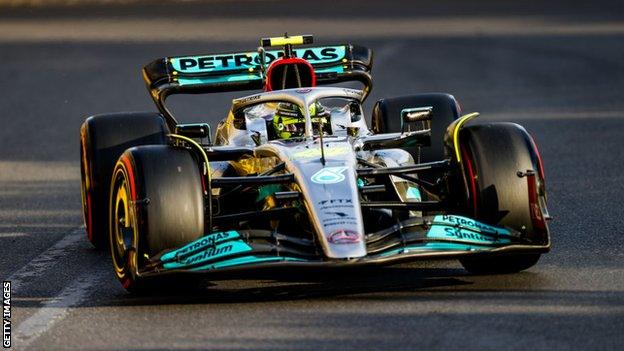Formula 1: FIA to set bouncing limit from French Grand Prix
- Published

Hamilton finished fourth in Azerbaijan but described his experienced in the 51-lap race as "painful"
Formula 1's governing body has acted to limit the amount cars can "bounce" on safety grounds.
The moves comes after the drivers collectively asked the FIA to intervene on the topic, which has arisen as a result of new rules this year.
The FIA has determined a metric that defines the maximum amount of bouncing a car will be allowed to do.
It will come into force at the French Grand Prix on 22-24 July to give teams sufficient chance to adjust their cars.
Drivers are concerned about potential heath problems - both short and long term - from the phenomenon.
The "bouncing" problem has arisen because new technical rules have re-introduced a phenomenon known as "ground effect", which requires cars to be run very stiff and as low as possible for maximum performance.
Since the start of the season, it has become clear that this has been creating physical problems for drivers.
For example, Lewis Hamilton was subjected to vertical forces as high as 10G in the course of the Azerbaijan Grand Prix earlier this month.
There are two related but separate issues - "porpoising", an aerodynamic phenomenon caused by underbody airflow disruption, which leads to a high-frequency vertical oscillation; and "bouncing", caused when the cars' floors hit the track.
Some teams are suffering worse than others, with Mercedes at the more extreme end of the scale, but drivers from all teams have expressed their concerns on the issue behind closed doors.
The FIA measured the behaviour of all cars at the Canadian Grand Prix two weeks ago.
In a statement on Thursday before the British Grand Prix, the FIA said: "The FIA's analysis of vertical oscillation data has concluded, and we have defined a metric by which to monitor this.
"The update has been sent to teams to allow them to conduct their own analysis over the next two grands prix to understand what, if any, changes they may need to implement in order to be compliant when the technical directive becomes effective as of the French Grand Prix."
It added that the directive also set new limits relating to the wear of the underbody plank - a device fitted to the floor of the cars to limit how low they can be run - and to the stiffness of cars' underbody titanium skid plates, "which are inherently related to the same issue, and go hand-in-hand with the metric".
"These changes are necessary in order to provide a level playing field between the teams when the metric is implemented."
The issue has become an emotive one - Mercedes team boss Toto Wolff had a row with his opposite numbers at Red Bull and Ferrari in Canada, accusing them of "pitiful" and "disingenuous" behaviour in preventing changes to solve bouncing.
The argument took place in a team principals' meeting with F1 chairman Stefano Domenicali, which was being filmed for Netflix's Drive to Survive documentary series.